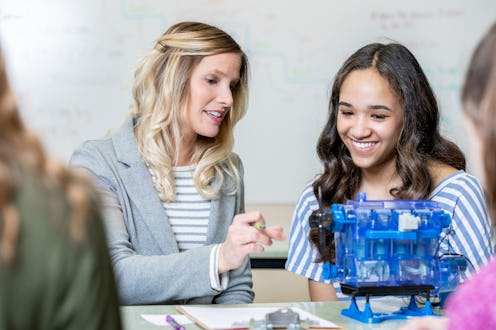Life
What The UK Science Curriculum *Should* Look Like, According To A STEMinist Teacher

Ask someone to name a female scientist and you may find yourself waiting a long time for the answer. In fact, education charity Teach First recently found only half of British adults could do so. Despite a great deal of female role models to look up to, the science industry's historic focus on male achievements has resulted in a sorry state of affairs. But one Teach First ambassador has shown just how easy it is to create what she's calling a STEMinist curriculum and prove to students there's a place for everyone in science, technology, engineering, and maths.
Even though global figures show that more women than men graduate with science degrees, this number significantly drops when you reach PhD and researcher level, states the World Economic Forum (WEF). Men actually make up nearly three-quarters of scientific researchers, the WEF states.
There are likely a number of reasons for the lack of female representation in science's highest echelons, including the gender pay gap and stereotyping. However, one woman believes it starts much earlier than many of us realised. Kirsty Simkin, a Teach First ambassador and primary school teacher at Reach Academy in Feltham, says "we need to look at how [science] is taught," explaining that there's not nearly enough emphasis being placed on female role models in educational settings.
Recent research by Teach First found there is not one single female scientist mentioned in the current GCSE science curriculum. "If girls can’t see themselves in these subjects, it holds them back," says Simkin.
To combat this, Simkin has taken it upon herself to create a female-focused science curriculum for primary-age students. Her plan incorporates 10 female scientists, highlighting their achievements "so that science resonates just as much with the girls as the boys." Simkin has already begun teaching to the curriculum to her own pupils and hopes that other teachers will follow suit.
Simkin's curriculum features a number of fascianting women. For example, the first woman to discover a comet and first woman to be paid for her scientific work, Caroline Herschel, is referenced in Year 2's space module and Florence Nightingale in their human health and lifestyle one.
Then there's palaeontologist Mary Anning, whose career inspires a mock fossil excavation exercise for Year 4 or Year 5. Similarly, conservationist Jane Goodall can slot nicely into Year 5's focus on human impacts on the planet. And women who've broken astronomy records — including the first woman in space, Valentina Tereshkova, and the first African-American female astronaut, Mae C. Jemison — can be incorporated into exercises where pupils record video messages to their families or write diary entries as if preparing for a rocket launch. Even the whole school can get involved by planning an assembly on notable women throughout STEM history.
"Small changes in the way we teach science can make a difference and break down the barriers for young girls," Simkin says. "My hope is that by the time my girls reach GCSE level, they subconsciously have role models to stem from when thinking about their futures.
"These role models come from these scientists they learn about, but I also hope it comes from me. Having teachers in classrooms that are working hard to break down these stereotypes can make the greatest difference. And this doesn’t just come from female teachers — I see fantastic male teachers working so hard every day to be great role models to girls too."
With the nation in the midst of British Science Week, it seems an apt time to heed Simkin's words. As she says, even the smallest of changes can make a lifelong difference.
This article was originally published on